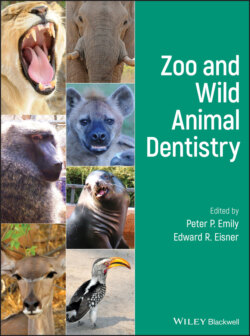Читать книгу Zoo and Wild Animal Dentistry - Группа авторов - Страница 18
Early Evolution
ОглавлениеFrom their reptilian ancestors, the earliest mammals inherited dentition subdivided into incisiform, caniniform as well as premolar and molariform teeth. Anterior post canines were lost and not replaced. Molariform teeth seemed to have been added to the distal arcade, a dental characteristic typical to mammals, though this characteristic was not seen in early mammals. Unlike tribosphenic teeth, their occlusal surfaces require extensive abrasion to come into occlusion. Marsupials and placentals differentiated from a common ancestral stock of mammals possessing tribosphenic dentition. This differentiation took place before the end of the early Cretaceous, approximately 100 million years BCE.
Figure 2.2 Dimetrodon.
Source: A.S. Romer [2].
Figure 2.3 Edaphosaurus (From Romer [1968] [2]).
Source: Teeth and Dentition in the Different Groups of Vertebrates page 172, as published in Comparative Odontology, by Bernhard Peyer, translated and edited by Rainer Zangerl, with a forward by Alfred S. Romer with permission. University of Chicago Press 1968. Library of Congress Catalog Card number 66‐20578. Previously published in A.S. Romer an L.I. Price's article “Review of the Pelycosauria” in Geological Society of America Special publications, Volume 28. GS of A Special Publications allows “use up to three items (…figures…) from GSL published material without permission or charge with acknowledgement of source.”
The plant‐eating ancestral reptilian dinosaurs had leaf‐shaped homodont dentition. Since they were browsers, the need for broad occlusal surfaces was not seen until the evolution of grazers.
Early mammals of the Triassic period wore the occlusal surfaces into occlusion as did their reptilian contemporaries. They had dentition unlike teeth of the tribosphenic pattern. Their occlusion required a significant amount of abrasion before they matched. The earliest mammals investigated by Moss and Pool lacked the prismatic structure of enamel.
The earliest mammal molariform teeth, prior to development of a true tribosphenic molar, produced a different action. This was more of a shearing action between the crests of the trigon and stylar shelf and those of the talonid and trigon. Food could still be crushed between these segments. By the early Cretaceous period,100 million years BCE. Mammals with fully developed tribosphenic dentition were in existence.
Figure 2.4 Snout fragment of an ichthyosaur (After Quenstedt from Peyer [3] [1937]).
Source: Teeth and Dentition in the Different Groups of Vertebrates page 144, as published in Comparative Odontology, by Bernhard Peyer, translated and edited by Rainer Zangerl, with a forward by Alfred S. Romer with permission. University of Chicago Press 1968. Library of Congress Catalog Card number 66‐20578. Originally appeared in Handbuch der vergleichenden Anatomie der Wirbeltiere Gesamt‐Inhaltsubersucht published originally by Urban & Schwarzenberg and acquired by Elsevier.
Even though mammals existed as far back as 200 million years BCE, most of the dentition had been extensively altered during the previous 100 million years BCE, or more. The extinction of the dinosaurs around 65.5 million years BCE precipitated a rapid evolution in mammalian dentition.
